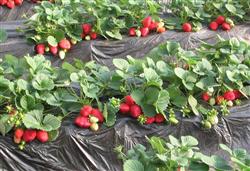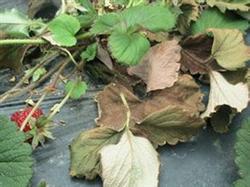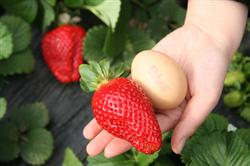Strawberry management in early spring

Strawberry is a perennial herb, which has the advantages of easy reproduction, simple management and early ripening. Strawberry is a kind of cash crop with low investment, quick effect and high benefit. First, the sprouting and growing period of strawberries is usually from late February to early March. In early spring, when the temperature rose to 2 ℃ and the soil 10 cm deep was stabilized at 1 ℃, depending on the nutrients stored in the rhizome and roots, the roots began to grow, and new roots gradually formed with the increase of soil temperature. After about 10 days of root growth, the rhizome began to sprout and new leaves appeared one after another. This period requires the field to maintain a maximum water holding capacity of more than 70%, fertile soil, well-drained neutral and slightly acidic soil, and the temperature above 5 ℃. The time for the first removal of cold protection in early spring should be carried out in time after thawing. First remove some of the cold protection from the thawed soil layer in order to increase the ground temperature. The time to remove the cold shield for the second time can be carried out before the bud is about to germinate, and it is too late to damage the new stem of strawberry. In the lower layer of the garden covered with plastic film for cold protection, it is appropriate to break the film according to the seedling during the bud in March, and the seedling plant should be lifted to the film to grow. Second, weeding strawberries with shallow roots and like moist and loose soil, while ploughing and loosening soil, weeding is beneficial to soil ventilation and microbial activity, promote the decomposition of organic matter, enrich and improve soil nutrients. After removing the cold shield and cleaning in early spring, shallow ploughing should be carried out in time. After rain, the depth of ploughing is 3mi 4cm, and other ploughing is usually arranged after irrigation. Third, timely topdressing strawberries like fertilizer, which requires a large amount of fertilizer and needs to absorb a lot of nutrients from the soil every year. It is estimated that for every 667 m 2 land to harvest 750 kg of fruit, 10 kg of pure nitrogen, 2.5 kg of phosphorus and 10 kg of potassium are needed. Under the premise of fully applying organic fertilizer, after soil thawing, strawberry topdressing was carried out for the first time before sprouting, applying 10 kg urea or 15 kg compound fertilizer every 667 m 2. The fertilizer should be dissolved in water before use to avoid root damage. Fourth, irrigation and drainage strawberries have high requirements for moisture, and the soil in the garden should always be kept moist. It should be combined with irrigation after each topdressing. After removing the cold shield in spring, irrigate for the first time. The appropriate irrigation time is morning and evening every day, which is more conducive to the growth and development of strawberries and can reduce fruit decay. Garden plots with heavy, low-lying soil or high groundwater level should pay special attention to drainage to prevent flooding. 5. Prevention and control of insect pests in early spring, when underground pests (grub, mole cricket, ground tiger and golden needle worm, etc.) are found to damage strawberry roots and stems, countermeasures can be taken: ① shallow ploughing in early spring can effectively eliminate eggs and larvae in weeds and soil; ② artificially dug up ground tigers and grubs near the injured plants. Every 667m 2, ③ uses 200g of 90% crystal trichlorfon 200g or 50% phoxim emulsion 200ml 300g, 500ml 700g of water, and then irrigates the roots; ④ baits are used for control, and the mildew bait is prepared by mixing 2.5kg of fried wheat bran or cake, or 10kg of chopped fresh grass into 1.5kg of water.
- Prev

How to control strawberry Fusarium wilt management measures
Strawberry Fusarium wilt is a kind of fungal vascular bundle disease transmitted by soil, which can occur from seedling stage to harvest stage. Prevention and control methods: 1. Strengthen cultivation management. Drain water in time after rain. Diseased plants were found to be removed and destroyed in time, sterilized by spraying drugs, and new high-fat membranes should be added to enhance the efficacy. 2. Flowers and fruits.
- Next

Prevention of Strawberry Diseases and insect pests in Summer and matters needing attention
The application of boron and iron fertilizer can improve the quality of strawberries. At present, strawberries have been put on the market on a large scale, but with the growth and harvest of strawberries, farmers ignore the application of trace elements and unreasonable use of fertilizer, resulting in the lack of trace elements needed for strawberry growth. in particular, the symptoms of boron and iron deficiency are particularly obvious, which have affected the yield of strawberries.
Related
- Moge, come on! The staff of the peasant association in the producing area of cantaloupe were frightened when the crowd gathered.
- Causes and Solutions of low Fruit setting rate of Apple
- Symptoms and control measures of passion fruit virus disease
- Fruit growing lesson: how do apple orchards keep high yields?
- Can you build orchards in the mountains? What are the pros and cons?
- How to manage the coloring period of Crisson grape?
- This paper introduces the processing technology of two kinds of fig products.
- How much is a month for retired teachers in rural areas by 2020?
- How can strawberry planting increase sugar content? We should pay attention to management in many aspects.
- What are the cultivation techniques on how to improve the yield of golden fruit?

